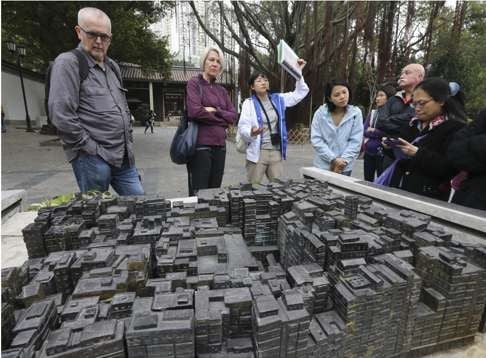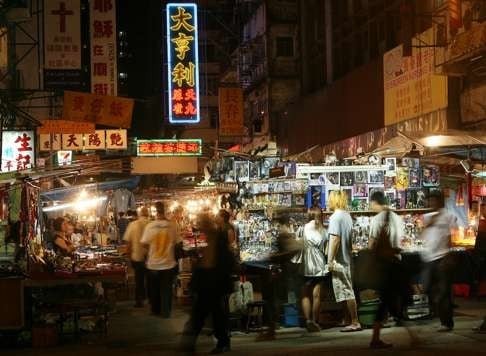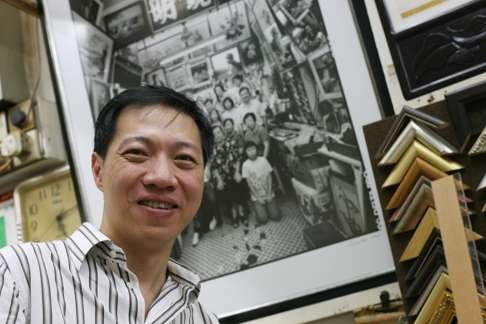
What walking-tour guides show visitors looking for the real Hong Kong
From skyscrapers to salt pans, old neighbourhoods and food shops, an increasing number of operators are showing tourists what makes Hong Kong special through its culture and history
Australian tourists Mike Baker and his wife Margo Couldrey recall a few highlights of their recent holiday in Hong Kong. They mention an old shop where they enjoyed a tofu dessert. There was also a stroll around Kowloon Walled City Park to see preserved remnants of the teeming squatter settlement that once occupied the site.

“When we are in other cities, we like walking tours because they allow you to look deeper. They have local people taking you around,” says Baker, from Brisbane. “We don’t just want to see the present day Hong Kong, but also its past – the pre- and post-colonial times. We want to see history and heritage.”
Couldrey says she is far more interested in tasting cheap street food than visiting celebrated restaurants.
“I know there are a lot of Michelin-starred restaurants here, but they aren’t for us. We like food made by locals,” she says.

Chan says his experience of walking tours in Europe inspired him to create similar adventures for visitors to Hong Kong.
“The government is always trying to boost tourism by undertaking large-scale construction projects, such as theme parks and shopping malls, or organising one-off mega events. But these kind of things are found all over the world,” he says. “A city’s character and culture have to be found in context and cannot be manufactured. There’s a lot of untapped tourism potential in Hong Kong.”
Chan’s observation comes at a time when the local tourism industry is flagging. The cooling Chinese economy and reduction in the number of mainland tourists have given Hong Kong’s luxury retail and tourism sectors the jitters, with brand-name boutiques in tourist hotspots scaling back and the hospitality industry hit hard by unemployment.
Tourism Board figures show visitor numbers dropped 2.5 per cent to 59 million people in 2015. About 77 per cent – or 45 million visitors – were from China, a year-on-year drop of 3 per cent. Hoping to arrest the fall, Financial Secretary John Tsang Chun-wah set aside HK$380 million in February’s budget to revive tourism.
Of that figure, HK$100 million will be alloted to the Tourism Board to produce a star-studded promotional video for overseas broadcast. Some HK$50 million will be used to strengthen events such as the annual Wine and Dine month, Hong Kong Cyclothon and the Hong Kong Sevens rugby tournament. Meanwhile, there are plans to transform Lantau into a new tourism and recreation hub, with spa resorts and shopping malls.

The government neglects local culture and only cares about big events. The old districts are rich in interesting stories reflecting the lives of ordinary Hongkongers
“We will soon launch a new tour that takes visitors to locations featured in classic films. They will be able to take a pilgrimage to sites seen in The World of Suzie Wong [1960] and Rouge [1987, starring the late Anita Mui Yim-fong].
“The tour will start at the Western Market in Sheung Wan, and will visit the Man Mo Temple on Hollywood Road, Tai Ping Shan Street, Wing Lee Street and PMQ [the former police married headquarters turned cultural hub]. We have cleared the copyright with movie studios so we can take a portable projector on the trip to show clips on site.”
A personal touch helps the walking tours stand out from those run by travel agencies. The Yau Ma Tei night tour is led by Chan, who grew up in Temple Street.

The Hong Kong Institute of Surveyors started organising weekend tours in and around Central last summer, but with more of an architectural orientation.

Thomas Ho Kwok-kwan, the institute’s vice-president, says these walking tours help visitors gain a better understanding of the city.
“People visiting the IFC just think of it as a towering commercial building. But its design illustrates a unique characteristic of Hong Kong,” Ho says. “It is also a transport hub, comprising the [Hong Kong] station, bus and minibus terminals. Hong Kong was the first place in the world to construct developments above the railway network. In the ’80s, the first was the Telford cluster above the [Kowloon Bay] station. Heng Fa Chuen and Taikoo Shing followed later,” he says. “The construction of the railway network has made Hong Kong much more convenient for residents and has driven the development of malls and housing estates. This model has since been imitated by other cities, such as Beijing and Shenzhen.”

“Yim Tin Tsai has its recently revived salt pans [dating to the 19th century]. There’s also a beautiful Catholic church there. Like Yim Tin Tsai, High Island used to be inhabited by many villagers who later deserted the island [moving to the city or overseas]. There’s a big Tin Hau temple, which hosts a week-long festival every year.”
Many of the tours offered by Hulu Culture take visitors to old shops, where they can chat with artisans making objects such as old Chinese scales and lanterns. But Go, a veteran photographer, says Hong Kong’s cultural heritage is disappearing rapidly as old districts are demolished to make way for urban
redevelopment projects.
“The government neglects local culture and only cares about big events. The old districts are rich in interesting stories reflecting the lives of ordinary Hongkongers. The mix of old and new is among the unique traits of Hong Kong, but the old is quickly being replaced by gentrification.”
#SoHongKong: look for this tag on social media for more stories about what makes Hong Kong unique - and find out how you can join in.

